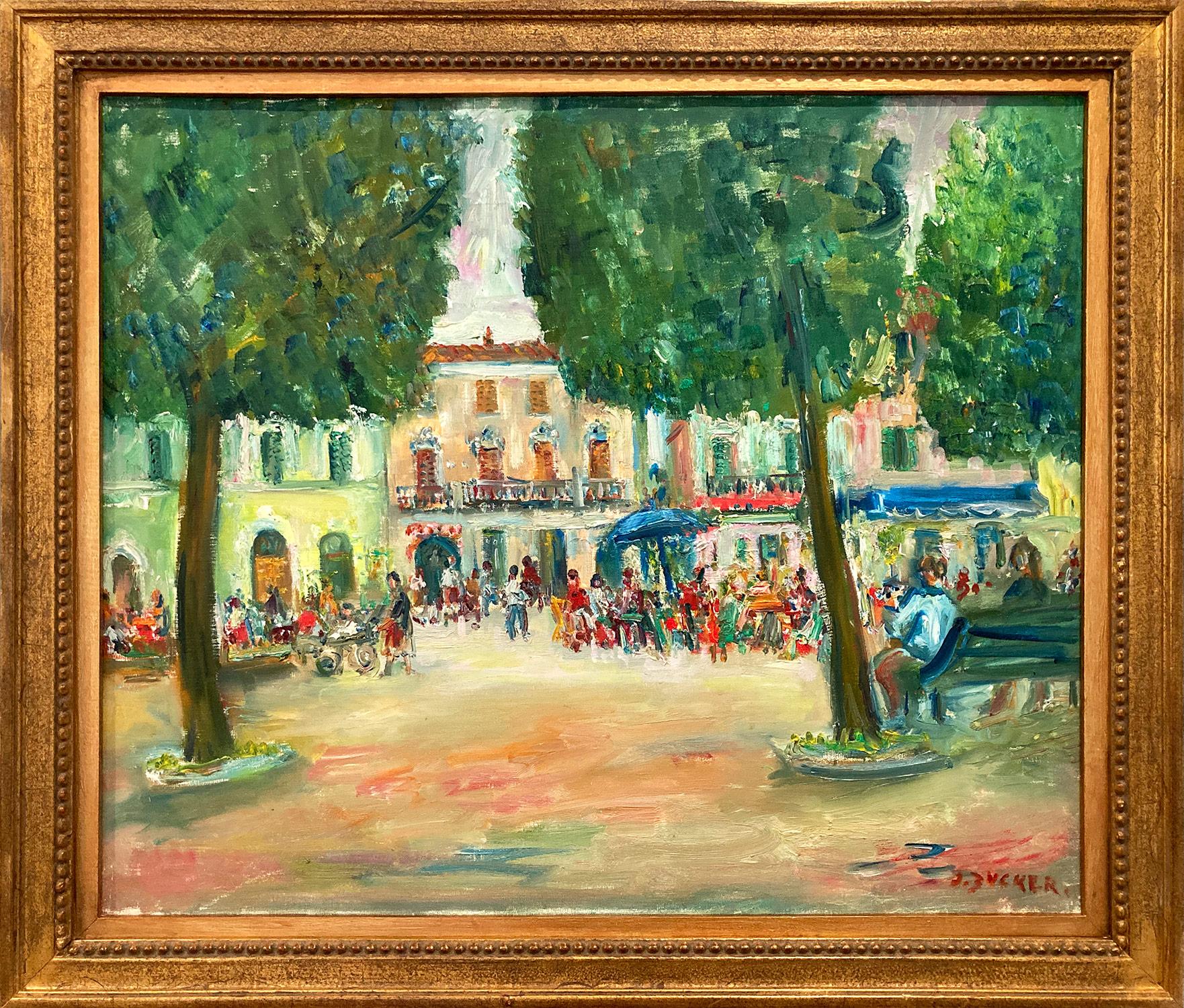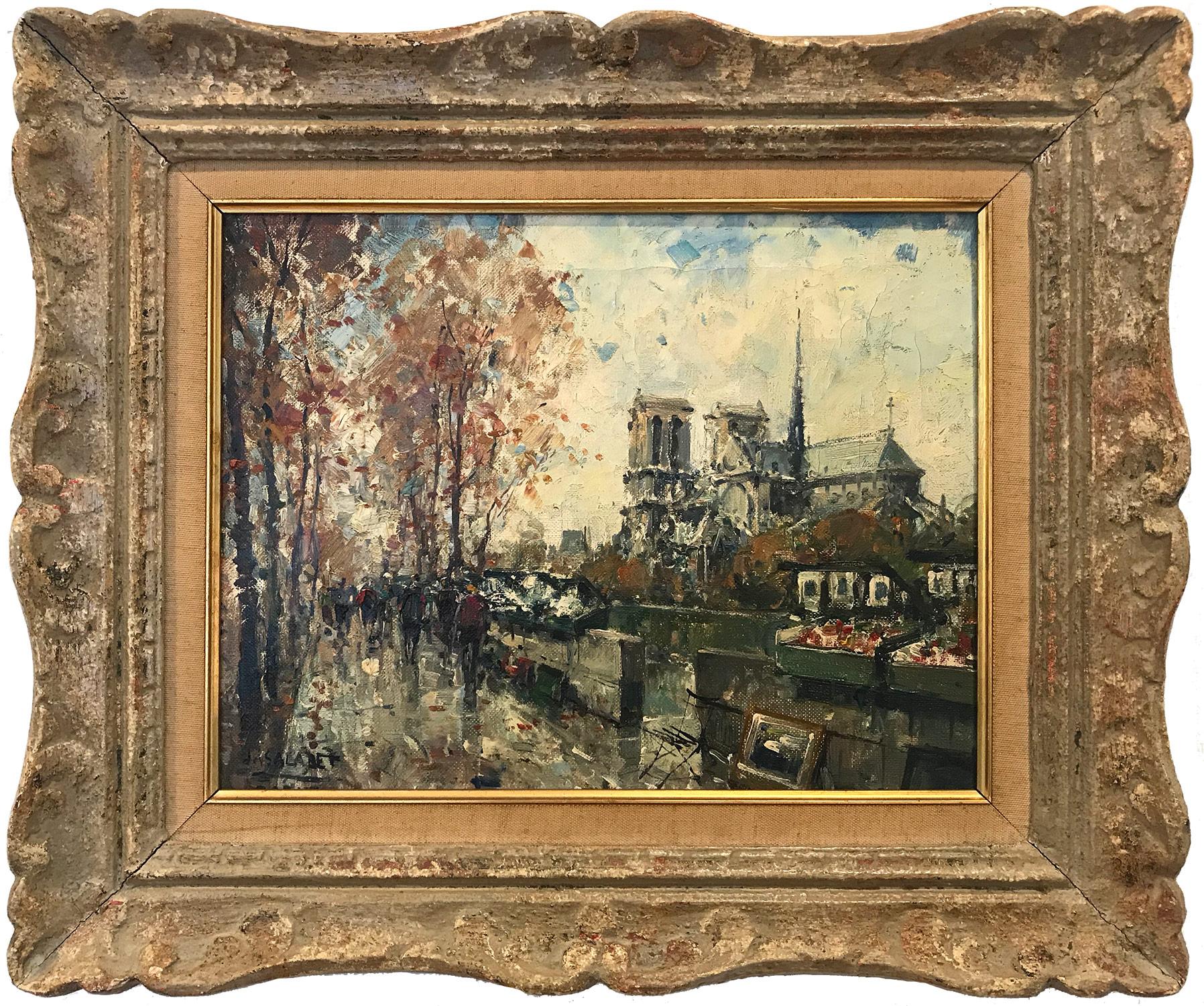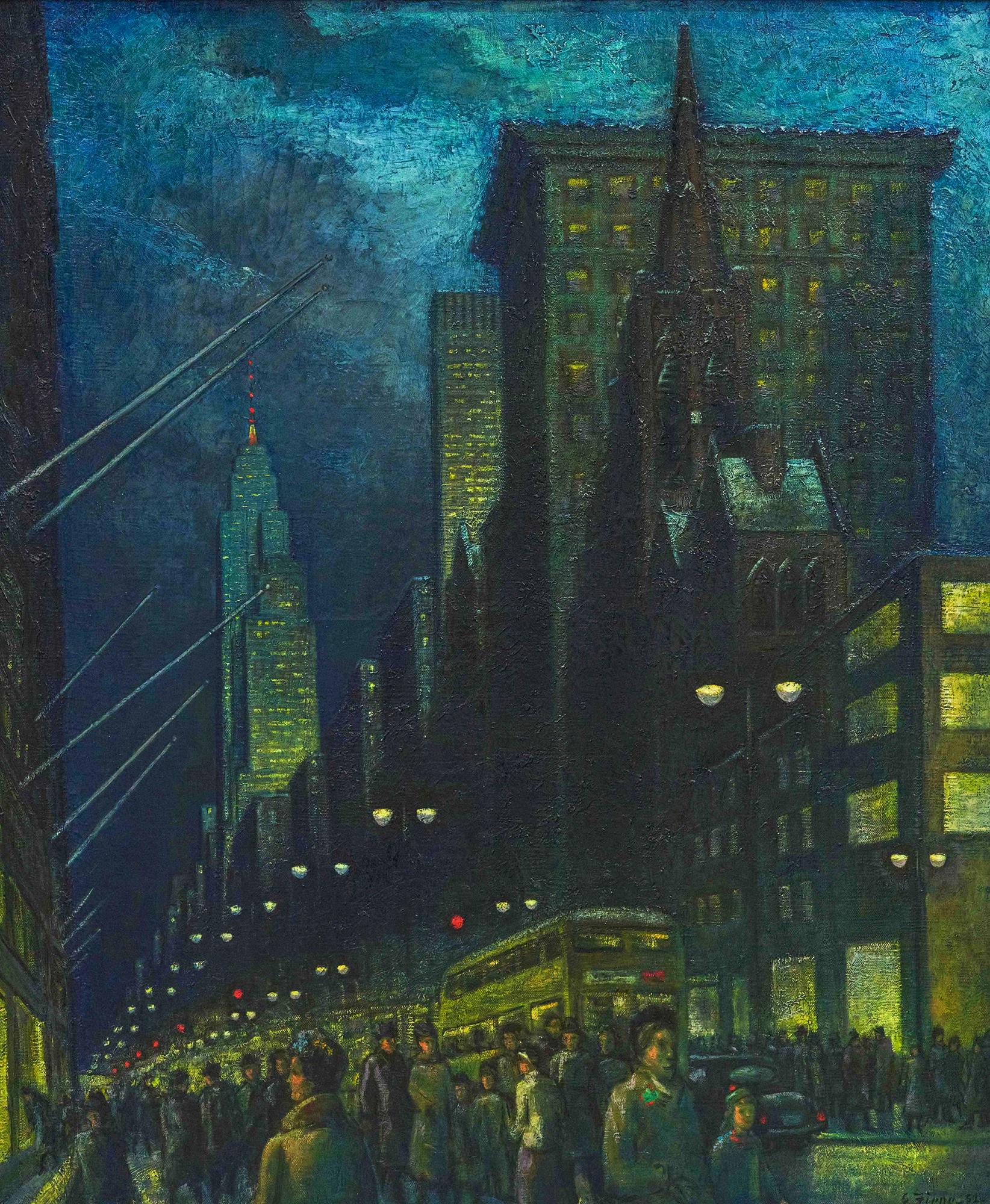Items Similar to Paysage d'Hiver by Paulémile Pissarro - River scene, oil painting
Want more images or videos?
Request additional images or videos from the seller
1 of 12
Paul Emile PissarroPaysage d'Hiver by Paulémile Pissarro - River scene, oil paintingcirca 1955
circa 1955
About the Item
*UK BUYERS WILL PAY AN ADDITIONAL 20% VAT ON TOP OF THE ABOVE PRICE
Paysage d'Hiver by Paulémile Pissarro (1884-1972)
Oil on canvas
54 x 65 cm (21 ¹/₄ x 25 ⁵/₈ inches)
Signed lower right, Paulémile- Pissarro.
Signed and titled on the stretcher
Executed circa 1955
This work is accompanied by a certificate of authenticity by Lélia Pissarro and will be included in the forthcoming catalogue raisonné.
Artist biography
Paulémile Pissarro, Camille Pissarro’s youngest son, was born in Éragny in 1884 where he was brought up within the creatively fertile environment of his family home and, encouraged by his father, began drawing at an early age. Paulémile’s godfather was Claude Monet, who became his teacher and legal guardian after Camille’s death in 1903.
In 1905 Paulémile exhibited at the Salon des Indépendants for the first time. Although his father had supported Paulémile’s desire to be an artist, his mother was eager for him to learn a more practical trade. Therefore in 1908 he put aside his artistic pursuits to work as an automobile mechanic and test-driver, then later as a lace and textile designer, allowing him only a limited time to paint. Paulémile only fully dedicated himself to painting following a letter from his brother Lucien in London, who wrote to invite him to take part in an exhibition held in London. Subsequent to the successful sale of a number of watercolours he had sent over, the young artist became inspired to leave the textile factory and pursue a career in art.
By the 1920s Paulémile had become an established Post-Impressionist artist in his own right, spending the summer months escaping from Paris on painting trips with fellow artists Kees Van Dongen, Raoul Dufy, Maurice de Vlaminck and André Dunoyer de Segonzac. In 1922 Paulémile purchased a house in Lyons-la-Forêt, a small village within the region of his hometown of Éragny and Giverny, where he moved in with his first wife Berthe Bennaiche. During this time, he developed a form of Cubism inspired by Paul Cézanne whom he dearly admired, creating some wonderful paintings of the river Eure and its surrounding villages. There he formed a close friendship with his neighbour, the famous Art Deco designer Émile-Jacques Ruhlmann, who designed a stunning Art Deco studio for Paulémile adjacent to his house.
In 1930 he visited and fell in love with the Swiss Normandy area in the Calvados region, in particular the River Orne which runs through the valley adjacent to the villages of Clécy and St. Remy. The combination of rolling hills, bold meadows and the calm river weaving its way through the landscape offered Paulémile a new burst of inspiration. With his second wife Yvonne Beaupel, Paulémile eventually moved to Clécy in 1935, where he would remain for the rest of his life. Of their three children, both H. Claude and Yvon also became artists.
With his house backing on to the river Orne, Paulémile developed a new way of working using a boat as a floating studio, where he spent countless days painting the calm waters from between the riverbanks. Here the influence of his godfather Claude Monet became apparent, particularly in Paulémile’s depiction of water, which was revolutionised by the Impressionist icon. He also applied Monet’s lessons in horticulture to the creation of an abundant garden, offering him many more motifs for his new paintings. Alongside these river landscapes, he also painted the neighbouring hay fields, various snow scenes, some interiors and still lives. The most ambitious work in his oeuvre was a fresco painted on all four walls of his own dining room, depicting the adjacent river in which he includes family members, neighbours and friends.
In 1967 Paulémile had his first one-man show in the United States at Wally Findlay Galleries in New York. This led to widespread recognition and a degree of professional success that few Pissarro artists knew during their lifetime. Since his death in 1972, Paulémile remains one of the best known of Camille’s sons.
- Creator:Paul Emile Pissarro (1884-1972, French)
- Creation Year:circa 1955
- Dimensions:Height: 21.26 in (54 cm)Width: 25.6 in (65 cm)
- Medium:
- Movement & Style:
- Period:
- Condition:
- Gallery Location:London, GB
- Reference Number:1stDibs: LU26129786032
About the Seller
5.0
Recognized Seller
These prestigious sellers are industry leaders and represent the highest echelon for item quality and design.
Gold Seller
These expertly vetted sellers are highly rated and consistently exceed customer expectations.
Established in 1964
1stDibs seller since 2015
95 sales on 1stDibs
Typical response time: 8 hours
Associations
Society Of London Art Dealers
- ShippingRetrieving quote...Ships From: London, United Kingdom
- Return PolicyA return for this item may be initiated within 7 days of delivery.
More From This SellerView All
- La Rivière by PAULÉMILE PISSARRO - Post Impressionist Landscape Painting, RiverBy Paul Emile PissarroLocated in London, GB*UK BUYERS WILL PAY AN ADDITIONAL 20% VAT ON TOP OF THE ABOVE PRICE La Rivière (The River) by PAULÉMILE PISSARRO (1884-1972) Oil on canvas 92 x 73 cm (36 1⁄4 x 28 3⁄4 inches) Signed...Category
1930s Post-Impressionist Landscape Paintings
MaterialsOil, Canvas
- La Rivière Orne et le Pain de S by PAULÉMILE PISSARRO - Oil, Post-ImpressionistBy Paul Emile PissarroLocated in London, GB*UK BUYERS WILL PAY AN ADDITIONAL 20% VAT ON TOP OF THE ABOVE PRICE La Rivière Orne et le Pain de Sucre by PAULÉMILE PISSARRO (1884-1972) Oil on canvas 54 x 65 cm (21 ¼ x 25 ⅝ inch...Category
1940s Post-Impressionist Landscape Paintings
MaterialsCanvas, Oil
- Landscape painting by Paulémile Pissarro - 'Les Deux Arbres...'By Paul Emile PissarroLocated in London, GB*UK BUYERS WILL PAY AN ADDITIONAL 20% VAT ON TOP OF THE ABOVE PRICE Les deux arbres au bord de la rivière dans la forêt de Lyons by Paulémile Pissarro (1884-1972) Oil on canvas 65 x...Category
1950s Post-Impressionist Figurative Paintings
MaterialsCanvas, Oil
- Pont du Chemin de Fer à Moret by Georges Manzana Pissarro - River sceneBy Georges Henri Manzana PissarroLocated in London, GB*PLEASE NOTE UK BUYERS WILL ONLY PAY 5% VAT ON THIS PURCHASE. Pont du Chemin de Fer à Moret by Georges Manzana Pissarro (1871-1961) Oil on canvas 54.5 x 65.2 cm (21 ¹/₂ x 25 ⁵/₈ inc...Category
Early 1900s Post-Impressionist Figurative Paintings
MaterialsOil, Canvas
- La Voile Rose (Cognac) by H. Claude Pissarro - Post-Impressionist style paintingBy Hughes Claude PissarroLocated in London, GB*UK BUYERS WILL PAY AN ADDITIONAL 20% VAT ON TOP OF THE ABOVE PRICE La Voile Rose (Cognac) by H. Claude Pissarro (b. 1935) Oil on canvas 50 x 61 cm (19 ³/₄ x 24 inches) Signed lower...Category
21st Century and Contemporary Post-Impressionist Figurative Paintings
MaterialsCanvas, Oil
- L'Orne au Pont de Vey by H. Claude Pissarro - Post-Impressionist styleBy Hughes Claude PissarroLocated in London, GB*UK BUYERS WILL PAY AN ADDITIONAL 20% VAT ON TOP OF THE ABOVE PRICE L'Orne au Pont de Vey by H. Claude Pissarro (b. 1935) Oil on canvas 38 x 46 cm (15 x 18 ¹/₈ inches) Signed lower ...Category
21st Century and Contemporary Post-Impressionist Figurative Paintings
MaterialsCanvas, Oil
You May Also Like
- "Downtown Plaza" Post-Impressionism Landscape Oil Painting with Figures in PlazaBy Jacques ZuckerLocated in New York, NYA charming depiction of children playing by the park in a village setting. The colors are breathtaking, as the impressionistic details are noted with thicker use of paint. The compos...Category
20th Century Post-Impressionist Landscape Paintings
MaterialsOil, Canvas
- "Maxims Cafe Paris" Parisian City Street Scene with Maxims Cafe and FiguresBy Georges GerbierLocated in New York, NYGeorges Gerbier was known for his impressionistic street scenes depicting popular locations in Europe. This painting is a tremendously vivid and alive street scene from Paris in the ...Category
Mid-20th Century Post-Impressionist Landscape Paintings
MaterialsCanvas, Oil
- "Book Sellers by Notre Dame" Impressionist Parisian Street Scene Painting CanvasBy Jean SalabetLocated in New York, NYA beautiful oil on canvas painting by the French artist, Jean Salabet. Salabet was a Parisian painter known for his colorful cityscapes depicting the times of his generation. His work is comparable to those of Jules Herve, Antoine Blanchard and Edouard Cortes. This painting is a wonderful example of his work from the prime of his career. Here you see the artists vendors selling paintings along the view of Notre Dame de Paris, located on the Île de la Cité in the 4th Arrondissement of Paris. People are scattered throughout between the tree lined street. The details are magnificent as Salabet captures the architecture of Paris so beautifully; you can feel the energy of the day and the excitement. The painting comes displayed in original frame with hanging wire and is signed lower left. Art measures 10.75 x 13.75 in Frame measures 16.25 x 19.25 in Jean Salabet was a pseudonym used by the Spanish artist Juan Bayón Salado (1913-1995) in the mid-20th century. Juan Bayón Salado (Jean Salabet) was born in Bilbao Spain on June 24, 1913. He settled in Paris between 1950 and 1969 and when using the pseudonym Jean Salabet between 1950 and 1957 he was mainly selling his works through Mr...Category
Mid-20th Century Post-Impressionist Landscape Paintings
MaterialsCanvas, Oil
- "Boulevard of Paris", 20th Century oil on canvas by Spanish artist E. Grau SalaBy Emilio Grau SalaLocated in Madrid, ESEMILIO GRAU SALA Spanish, 1911 - 1975 BOULEVARD OF PARIS signed Grau Sala (lower right) oil on canvas 25-1/2 X 32 inches (65 X 81 cm.) framed: 36-1/4 X 42-1/2 inches (92 X 108 cm.) PROVENANCE Sale: Sotheby´s Olympia London, 20 October 2006 Emilio Grau Sala came from a family of artists. He was born in Barcelona in 1911 and his father, a good cartoonist, had been one of the promoters of the "Salon des Humanistes" and made his exhibitions normally in the Parés Hall. His first works were exhibited at the Salon des Independents, in the years 1930-33. Grau Sala was essentially a Mediterranean painter, son of post-impressionism and enriched with French painting of the last fifty years. In this work Grau Sala has a loose, subtle brushstroke, in which the color shapes the entire work. The bright and transparent whites that give life to young schoolgirls contrast with the brushstrokes of blacks from the nun who accompanies them. The explosion of greens is refreshing, it surrounds us and transports us to an idyllic place, even if it is a citizen boulevard, which becomes friendly and beautiful. His works can be found in the Museums of the Villa de Paris, L'Ile de France Museum, at the Château de Sceaux, Honfleur Museum, La Rochelle Museum, Barcelona Museum, Tossa de Mar...Category
1950s Post-Impressionist Landscape Paintings
MaterialsOil, Canvas
- Winter Evening Fifth Avenue - New York at NightBy Ernest FieneLocated in Miami, FLErnest Fiene depicts Fifth Avenue looking down from 57th Street with an unobstructed view of the Empire State Building. The absence of newer glass and steel architecture gives the painting the charm of old New York. The artist captures a dark, moody blue sky as light bounces back from the clouds. This contrasts with the somewhat haunting yellow glow given to pedestrians and street traffic. The people have somewhat of a zombie quality akin to George Tooker. Best viewed with a top and direct gallery light...Category
1950s Post-Impressionist Landscape Paintings
MaterialsOil, Canvas
- The Libertine Girls of Rue Saint DenisBy Jan KeldermanLocated in Paris, FRCharming Dutch 1950's oil on canvas painting signed by J. KELDERMAN In a very good general condition . It représents the libertine courtesan working ...Category
20th Century Post-Impressionist Figurative Paintings
MaterialsCanvas, Oil
Recently Viewed
View AllMore Ways To Browse
Dining Scene Art
Vintage Textile Painting
Cubism Painting 1920s
Art Deco Scene Painting
Deco Painting Man
Vintage Lace Frames
Letter Man Painting
Automobile Wall Art
Paysage Vintage
Art Deco Rolling
Andre Dunoyer De Segonzac
Claude Factory
Vintage Mechanic
Andre Monet
Yvonne Love
Dufy Raoul Village
Watercolor Boats 1950
Vlaminck Paintings For Sale





